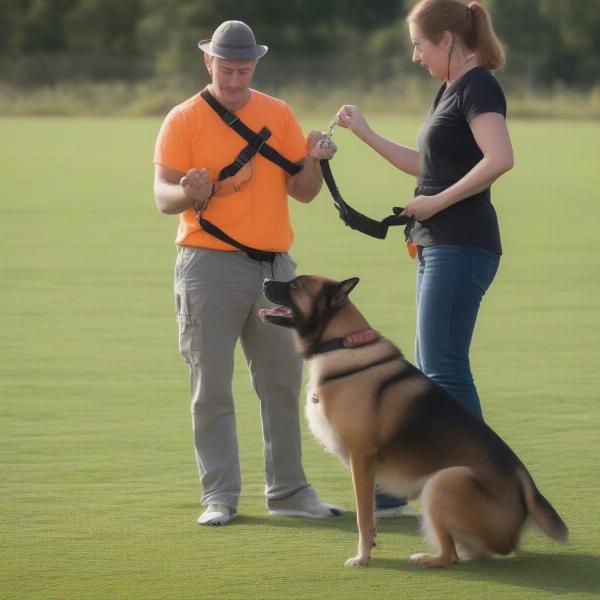Dog shock collars, also known as e-collars or training collars, are a controversial topic in Australia. While some owners find them a useful training tool, others express concerns about their potential for misuse and animal welfare. This guide aims to provide a comprehensive overview of dog shock collars in Australia, covering their legality, types, appropriate usage, potential risks, and ethical considerations.
Understanding Dog Shock Collars
Shock collars deliver a mild electric shock to a dog’s neck via metal contact points on the collar. The intensity of the shock can be adjusted, ranging from a slight tingling sensation to a more intense stimulus. They are often used as a training aid to address unwanted behaviours like excessive barking, aggression, or straying. In Australia, the legality and regulations surrounding shock collars vary by state and territory. Some jurisdictions have outright bans, while others permit their use with certain restrictions.
Types of Shock Collars in Australia
Several types of shock collars are available in Australia, though their availability may depend on local regulations. These include:
- Remote Trainer Collars: These allow the owner to deliver a shock remotely using a handheld transmitter. They offer greater control over timing and intensity.
- Bark Collars: These collars automatically deliver a shock when the dog barks, aiming to deter excessive barking.
- Containment System Collars: These are used in conjunction with an invisible fence system and deliver a shock when the dog approaches the boundary.
Using Shock Collars Responsibly
If using a shock collar, responsible and humane practices are crucial. It’s essential to:
- Consult a professional dog trainer: A qualified trainer can guide you on proper usage and help you integrate the collar into a comprehensive training program.
- Start with the lowest setting: Gradually increase the intensity only if necessary and never use a setting that causes the dog pain or distress.
- Pair the shock with positive reinforcement: Use the collar to interrupt unwanted behaviour and immediately follow up with positive reinforcement for desired actions.
 Dog Training with Shock Collar
Dog Training with Shock Collar - Avoid using shock collars on puppies or dogs with certain medical conditions: Consult your veterinarian before using a shock collar on any dog.
Potential Risks and Ethical Concerns
While proponents argue that shock collars can be effective, several risks and ethical concerns exist:
- Physical harm: Improper use can cause burns, tissue damage, and psychological distress.
- Negative associations: The dog may associate the shock with people, places, or other stimuli, leading to fear and anxiety.
- Increased aggression: In some cases, shock collars can exacerbate aggression or create new behavioural problems.
Alternatives to Shock Collars
Numerous humane and effective alternatives to shock collars exist:
- Positive reinforcement training: This method focuses on rewarding desired behaviours and ignoring or redirecting unwanted ones.
- Clicker training: This utilizes a clicker to mark desired behaviours, followed by a reward.
- Harness training: Harnesses provide more control and can be less aversive than collars.
- Behaviour modification: Working with a qualified dog behaviourist can address underlying behavioural issues.
Conclusion
Dog shock collars in Australia are a complex issue. While they may have a place in certain training situations, responsible and humane usage is paramount. It’s crucial to consider the potential risks and ethical implications before using a shock collar and to explore alternative training methods that prioritize positive reinforcement and the dog’s well-being. Ultimately, the goal should be to build a strong, positive relationship with your dog based on trust and understanding.
FAQs
- Are shock collars legal in Australia? The legality varies by state and territory. Check your local regulations.
- Can shock collars harm my dog? Improper use can cause physical and psychological harm.
- What are some alternatives to shock collars? Positive reinforcement training, clicker training, harness training, and behaviour modification are all humane alternatives.
- Should I use a shock collar on my puppy? It’s generally not recommended to use shock collars on puppies.
- Where can I find a qualified dog trainer? Your local veterinarian or animal shelter can provide referrals to qualified trainers.
- What is the best way to train my dog without a shock collar? Positive reinforcement training is a highly effective and humane method.
- Are there specific breeds that shouldn’t use shock collars? Consult your veterinarian for advice specific to your dog’s breed and health.
About ILM Dog
ILM Dog is your trusted international resource for all things dog-related. We provide expert advice on Dog Breeds and Selection, Health and Medical Care, Training and Behavior, Nutrition and Feeding, Grooming and Hygiene, and Products and Accessories. Our mission is to empower dog owners worldwide with the knowledge and resources they need to provide the best possible care for their canine companions. For tailored guidance or to learn more about our services, contact us at [email protected] or call +44 20-3965-8624. We’re here to help you and your furry friend thrive!